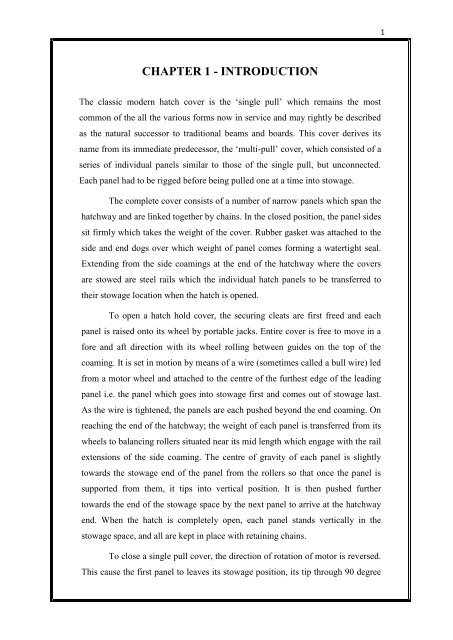Single pull macgregor type hatch cover.pdf - Cochin University of ...
Single pull macgregor type hatch cover.pdf - Cochin University of ...
Single pull macgregor type hatch cover.pdf - Cochin University of ...
You also want an ePaper? Increase the reach of your titles
YUMPU automatically turns print PDFs into web optimized ePapers that Google loves.
CHAPTER 1 - INTRODUCTION<br />
The classic modern <strong>hatch</strong> <strong>cover</strong> is the ‘single <strong>pull</strong>’ which remains the most<br />
common <strong>of</strong> the all the various forms now in service and may rightly be described<br />
as the natural successor to traditional beams and boards. This <strong>cover</strong> derives its<br />
name from its immediate predecessor, the ‘multi-<strong>pull</strong>’ <strong>cover</strong>, which consisted <strong>of</strong> a<br />
series <strong>of</strong> individual panels similar to those <strong>of</strong> the single <strong>pull</strong>, but unconnected.<br />
Each panel had to be rigged before being <strong>pull</strong>ed one at a time into stowage.<br />
The complete <strong>cover</strong> consists <strong>of</strong> a number <strong>of</strong> narrow panels which span the<br />
<strong>hatch</strong>way and are linked together by chains. In the closed position, the panel sides<br />
sit firmly which takes the weight <strong>of</strong> the <strong>cover</strong>. Rubber gasket was attached to the<br />
side and end dogs over which weight <strong>of</strong> panel comes forming a watertight seal.<br />
Extending from the side coamings at the end <strong>of</strong> the <strong>hatch</strong>way where the <strong>cover</strong>s<br />
are stowed are steel rails which the individual <strong>hatch</strong> panels to be transferred to<br />
their stowage location when the <strong>hatch</strong> is opened.<br />
To open a <strong>hatch</strong> hold <strong>cover</strong>, the securing cleats are first freed and each<br />
panel is raised onto its wheel by portable jacks. Entire <strong>cover</strong> is free to move in a<br />
fore and aft direction with its wheel rolling between guides on the top <strong>of</strong> the<br />
coaming. It is set in motion by means <strong>of</strong> a wire (sometimes called a bull wire) led<br />
from a motor wheel and attached to the centre <strong>of</strong> the furthest edge <strong>of</strong> the leading<br />
panel i.e. the panel which goes into stowage first and comes out <strong>of</strong> stowage last.<br />
As the wire is tightened, the panels are each pushed beyond the end coaming. On<br />
reaching the end <strong>of</strong> the <strong>hatch</strong>way; the weight <strong>of</strong> each panel is transferred from its<br />
wheels to balancing rollers situated near its mid length which engage with the rail<br />
extensions <strong>of</strong> the side coaming. The centre <strong>of</strong> gravity <strong>of</strong> each panel is slightly<br />
towards the stowage end <strong>of</strong> the panel from the rollers so that once the panel is<br />
supported from them, it tips into vertical position. It is then pushed further<br />
towards the end <strong>of</strong> the stowage space by the next panel to arrive at the <strong>hatch</strong>way<br />
end. When the <strong>hatch</strong> is completely open, each panel stands vertically in the<br />
stowage space, and all are kept in place with retaining chains.<br />
To close a single <strong>pull</strong> <strong>cover</strong>, the direction <strong>of</strong> rotation <strong>of</strong> motor is reversed.<br />
This cause the first panel to leaves its stowage position, its tip through 90 degree<br />
1

















